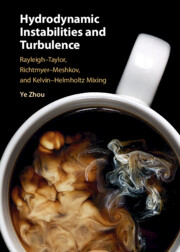 Hydrodynamic Instabilities and Turbulence
Hydrodynamic Instabilities and Turbulence Book contents
- Frontmatter
- Dedication
- Contents
- Preface
- Acknowledgments
- Part 1 Fundamentals
- Part 2 Hydrodynamics of Complex Flows
- 9 Influence of initial conditions
- 10 Flow properties
- 11 Rotation and time-dependent acceleration
- 12 Direction, strength, and shape of incident shock waves
- 13 Reshock andmulti-shocks
- 14 Combined instabilities
- 15 Geometrical configurations
- 16 Convergent/divergent geometry
- 17 Magnetohydrodynamic fluid instabilities
- Part 3 From the Microscopic to Cosmic Scales
- References
- Index
13 - Reshock andmulti-shocks
from Part 2 - Hydrodynamics of Complex Flows
- Frontmatter
- Dedication
- Contents
- Preface
- Acknowledgments
- Part 1 Fundamentals
- Part 2 Hydrodynamics of Complex Flows
- 9 Influence of initial conditions
- 10 Flow properties
- 11 Rotation and time-dependent acceleration
- 12 Direction, strength, and shape of incident shock waves
- 13 Reshock andmulti-shocks
- 14 Combined instabilities
- 15 Geometrical configurations
- 16 Convergent/divergent geometry
- 17 Magnetohydrodynamic fluid instabilities
- Part 3 From the Microscopic to Cosmic Scales
- References
- Index
Summary
After the RM instability grows from a first shock, it can be hit by a second shock. These reshock scenarios have been found in the key applications of inertial confinement fusion implosions or supernova explosions. In this chapter, I will introduce the efforts to model the growth of the mixing layer induced by the first shock and subsequent reshock and describe how the turbulence kinetic energy and anisotropy might be affected by the reshock events. Data from shock tube experiments and numeric simulations will also be introduced to provide insight into the reshock RM induced flows.
Keywords
- Type
- Chapter
- Information
- Hydrodynamic Instabilities and TurbulenceRayleigh–Taylor, Richtmyer–Meshkov, and Kelvin–Helmholtz Mixing, pp. 247 - 276Publisher: Cambridge University PressPrint publication year: 2024
